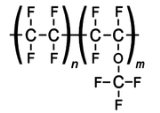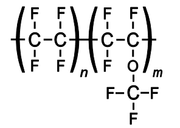
Perfluoroalkoxy
Encyclopedia
| PFA | |
|---|---|
 |
|
| Density Density The mass density or density of a material is defined as its mass per unit volume. The symbol most often used for density is ρ . In some cases , density is also defined as its weight per unit volume; although, this quantity is more properly called specific weight... |
2150 kg/m3 |
| Flexural modulus Flexural modulus In mechanics, the flexural modulus is the ratio of stress to strain in flexural deformation, or the tendency for a material to bend. It is determined from the slope of a stress-strain curve produced by a flexural test , and uses units of force per area... (E) |
586 MPa Pascal (unit) The pascal is the SI derived unit of pressure, internal pressure, stress, Young's modulus and tensile strength, named after the French mathematician, physicist, inventor, writer, and philosopher Blaise Pascal. It is a measure of force per unit area, defined as one newton per square metre... |
| Tensile strength Tensile strength Ultimate tensile strength , often shortened to tensile strength or ultimate strength, is the maximum stress that a material can withstand while being stretched or pulled before necking, which is when the specimen's cross-section starts to significantly contract... (t) |
24 MPa Pascal (unit) The pascal is the SI derived unit of pressure, internal pressure, stress, Young's modulus and tensile strength, named after the French mathematician, physicist, inventor, writer, and philosopher Blaise Pascal. It is a measure of force per unit area, defined as one newton per square metre... |
| Elongation @ break | 300% |
| Folding endurance | No break |
| Notch test | |
| Melting point Melting point The melting point of a solid is the temperature at which it changes state from solid to liquid. At the melting point the solid and liquid phase exist in equilibrium. The melting point of a substance depends on pressure and is usually specified at standard atmospheric pressure... |
305 °C Celsius Celsius is a scale and unit of measurement for temperature. It is named after the Swedish astronomer Anders Celsius , who developed a similar temperature scale two years before his death... |
| Maximum operating | |
| temperature | 260 °C Celsius Celsius is a scale and unit of measurement for temperature. It is named after the Swedish astronomer Anders Celsius , who developed a similar temperature scale two years before his death... |
| Water absorption (ASTM) | <0.03 % after 24 hours |
| Dielectric constant Dielectric constant The relative permittivity of a material under given conditions reflects the extent to which it concentrates electrostatic lines of flux. In technical terms, it is the ratio of the amount of electrical energy stored in a material by an applied voltage, relative to that stored in a vacuum... (Dk) |
|
| at 1MHz Hertz The hertz is the SI unit of frequency defined as the number of cycles per second of a periodic phenomenon. One of its most common uses is the description of the sine wave, particularly those used in radio and audio applications.... |
2.1 |
| Dissipation factor | |
| at 1MHz Hertz The hertz is the SI unit of frequency defined as the number of cycles per second of a periodic phenomenon. One of its most common uses is the description of the sine wave, particularly those used in radio and audio applications.... |
0.0001 |
| Arc resistance | < 180 seconds |
| Resistivity Resistivity Electrical resistivity is a measure of how strongly a material opposes the flow of electric current. A low resistivity indicates a material that readily allows the movement of electric charge. The SI unit of electrical resistivity is the ohm metre... at 50% R.H. Relative humidity Relative humidity is a term used to describe the amount of water vapor in a mixture of air and water vapor. It is defined as the partial pressure of water vapor in the air-water mixture, given as a percentage of the saturated vapor pressure under those conditions... |
> 1016 Ω Ohm The ohm is the SI unit of electrical resistance, named after German physicist Georg Simon Ohm.- Definition :The ohm is defined as a resistance between two points of a conductor when a constant potential difference of 1 volt, applied to these points, produces in the conductor a current of 1 ampere,... m |
Perfluoroalkoxy or PFA is a type of fluoropolymer
Fluoropolymer
A fluoropolymer is a fluorocarbon based polymer with multiple strong carbon–fluorine bonds. It is characterized by a high resistance to solvents, acids, and bases.-History:Fluoropolymers were accidentally discovered in 1938 by Dr. Roy J...
with properties similar to polytetrafluoroethylene
Polytetrafluoroethylene
Polytetrafluoroethylene is a synthetic fluoropolymer of tetrafluoroethylene that finds numerous applications. PTFE is most well known by the DuPont brand name Teflon....
(PTFE). It differs from the PTFE resins in that it is melt-processable using conventional injection molding
Injection molding
Injection molding is a manufacturing process for producing parts from both thermoplastic and thermosetting plastic materials. Material is fed into a heated barrel, mixed, and forced into a mold cavity where it cools and hardens to the configuration of the cavity...
and screw extrusion
Plastics extrusion
Plastics extrusion is a high volume manufacturing process in which raw plastic material is melted and formed into a continuous profile. Extrusion produces items such as pipe/tubing, weather stripping, fence, deck railing, window frames, adhesive tape and wire insulation.-Process:In the extrusion of...
techniques.
PFA was invented by DuPont and is sold under the brandname Teflon® PFA. Teflon® is better known as the trade name for PTFE. Other brandnames for granules are Neoflon® PFA from Daikin or Hyflon® PFA from Solvay Solexis
Solvay (company)
Solvay S.A. is a Belgian chemical company with its head office in Ixelles, Brussels, Belgium. It was founded in 1863 by Ernest Solvay to produce sodium carbonate by the solvay process. Since then the company has diversified to two major sectors of activity: chemicals and plastics...
.
PFA is very similar in composition to the fluoropolymer
Fluoropolymer
A fluoropolymer is a fluorocarbon based polymer with multiple strong carbon–fluorine bonds. It is characterized by a high resistance to solvents, acids, and bases.-History:Fluoropolymers were accidentally discovered in 1938 by Dr. Roy J...
s PTFE
and FEP (fluorinated ethylene-propylene)
Fluorinated ethylene propylene
Fluorinated ethylene propylene or FEP is a copolymer of hexafluoropropylene and tetrafluoroethylene. It differs from the PTFE resins in that it is melt-processible using conventional injection molding and screw extrusion techniques. Fluorinated ethylene propylene was invented by DuPont and is sold...
.
PFA and FEP both share PTFE's useful properties of low coefficient of friction and non-reactivity, but are more easily formable. PFA is softer than PTFE and melts at 305 °C.
Another version of polytetrafluoroethylene perfluoro methylvinylether, with a different ratio of PTFE and MVE monomers from PFA, is MFA.
Properties
Useful comparison tables of PTFE against FEPFluorinated ethylene propylene
Fluorinated ethylene propylene or FEP is a copolymer of hexafluoropropylene and tetrafluoroethylene. It differs from the PTFE resins in that it is melt-processible using conventional injection molding and screw extrusion techniques. Fluorinated ethylene propylene was invented by DuPont and is sold...
, PFA
Perfluoroalkoxy
Perfluoroalkoxy or PFA is a type of fluoropolymer with properties similar to polytetrafluoroethylene . It differs from the PTFE resins in that it is melt-processable using conventional injection molding and screw extrusion techniques....
and ETFE
ETFE
Ethylene tetrafluoroethylene, ETFE, a fluorine based plastic, was designed to have high corrosion resistance and strength over a wide temperature range. ETFE is a polymer, and its systematic name is poly. ETFE has a very high melting temperature, excellent chemical, electrical and high energy...
can be found on DuPonts website, listing the mechanical, thermal, chemical, electrical and vapour properties of each, side by side.
PFA is similar to FEP in terms of its mechanical properties. These two are both superior to PTFE with regards to their flexibility, making them useful for tubing applications. However, their ability to endure repetitive folding (flex life) is actually lower than PTFEs own. PFA has a higher flex life than FEP.
PFA is preferable to FEP where heat is concerned, but PTFE itself is slightly more resistant to heat than both. PFA is more affected by water absorption and weathering than FEP, but is superior in terms of salt spray resistance.
Perhaps the most impressive feature of PFA is its electrical properties, as it features the dielectric constant of PTFE, and an almost identical dissipation factor, but a dielectric strength that is around four times higher.
ETFE is effectively a high strength engineering version of these three, and features what would likely be considered to be slightly degraded performance when compared with the other three.
Applications
Due to its flexibility, extreme resistance to chemical attack and optical transparency, this material, along with FEPFluorinated ethylene propylene
Fluorinated ethylene propylene or FEP is a copolymer of hexafluoropropylene and tetrafluoroethylene. It differs from the PTFE resins in that it is melt-processible using conventional injection molding and screw extrusion techniques. Fluorinated ethylene propylene was invented by DuPont and is sold...
is routinely used for plastic labware and tubing that involves critical or highly corrosive processes. Nalgene is a well known laboratory supplier that makes extensive use of the two materials.
Another application are sheet linings for chemical equipment where fabric backed PFA sheets (SYMALIT® PFA). The use of a PFA liner allows to replace expensive metals and alloys like Inconel
Inconel
Inconel is a registered trademark of Special Metals Corporation that refers to a family of austenitic nickel-chromium-based superalloys. Inconel alloys are typically used in high temperature applications. It is often referred to in English as "Inco"...
or Hastelloy
Hastelloy
Hastelloy is the registered trademark name of Haynes International, Inc. The trademark is applied as the prefix name of a range of twenty two different highly corrosion-resistant metal alloys loosely grouped by the metallurgical industry under the material term “superalloys” or “high-performance...
with lined carbon steel or lined fibre-reinforced plastic
Fibre-reinforced plastic
Fibre-reinforced plastic is a composite material made of a polymer matrix reinforced with fibres. The fibres are usually fibreglass, carbon, or aramid, while the polymer is usually an epoxy, vinylester or polyester thermosetting plastic...
(FRP). Examples are SYMALIT® PFA lined columns, scrubbers, reactors and pipes which stand harsh environments like concentrated HF and HCl and halogens.

